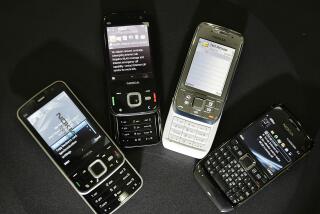They Can Hear You Now
IQUITOS, Peru — A few miles downriver from this city in the western Amazon jungle, Andres Alvarado hops off a boat and walks up a muddy path to a hollowed-out log resting on a wooden stand. He beats the log with a stick, sending a series of low-pitched tones into the rain forest.
“This is what they call the ‘telephone of the jungle,’ ” says Alvarado, a tricycle taxi-driver and tourist guide. Moments later, as children of the Bora Indian tribe come bounding down the path to answer the “telephone,” Alvarado’s belt begins beeping: It’s his cellphone.
Iquitos and nearby riverside hamlets are among the more remote outposts in South America’s expanding mobile phone system, part of a global network that is beginning to penetrate even the poorest and most undeveloped corners of the world.
For millions of people living in countries where getting a fixed phone line remains a bureaucratic impossibility, the cellphone revolution has allowed them to leapfrog from archaic forms of communication straight into the digital era -- and that is changing the fabric of their daily lives.
In East Africa, the mobile phone has brought a first, tantalizing taste of modernity to people who live on less than $10 a day. In China, the world’s biggest market for cellphones, they are embraced by rich and poor alike, a tiny pocket computer with which to surf the Internet, play video games or even do banking.
Here in Iquitos, where speedboats and lumbering old fishing craft ply the brown, wide waters of the Amazon, fishermen grab the wheels of their vessels with one hand and their cellphones with the other to check the price their catch will fetch at markets downriver.
Alvarado uses his mobile phone to round up clients for his tricycle taxi. And earlier this year, it beeped with the most important call of his life.
“My mother-in-law called me from the delivery room,” Alvarado recalled. His wife had gone into labor with their first child, and he raced to the hospital on his tricycle. “We all thought we were going to have a girl, but it turned out to be a boy.”
He flashed the news from the hospital to his sister in Lima via his cellphone, the kind of call that might seem routine in the United States but which still carries for him an aura of science fiction.
For Alvarado, a bright-eyed 23-year-old who has rarely traveled beyond the river cities and hamlets of the Amazon, the change brought about by the cellphone has been profound -- and rapid.
A few years back, when Alvarado’s grandfather died in a town several days’ journey upriver, his family in Iquitos learned the news by telegram. A mourning relative walked several hours to the telegraph office, dictated the sad news to a telegraph operator, who sent it to another office, where the message was typed up and delivered by hand to the Alvarado household.
“By the time we found out, they had already buried him,” Alvarado said.
The number of cellphones in Latin America has tripled since 1999, and one in five people now owns one. In Peru, as in many other countries in the region, there are more cellphones than fixed phone lines.
Today, the world’s fastest-growing cellphone markets are in places like Iquitos in rural South America and in sub-Saharan Africa, despite widespread poverty.
“My cellphone gives me an ‘address’ just like any other businessman,” said Baruwani Mbabazi, a money-changer who is part of a brisk trade in U.S. dollars in Kigali, the Rwandan capital. His $20 purchase of a used cellphone has liberated him from having to stand on the street waiting for customers.
“I can’t imagine my business without it,” Mbabazi said.
Rwanda’s cellphone boom has followed a pattern typical of many developing countries. It now has more than five times as many cellphones (134,000) as fixed telephone lines (23,000), according to the International Telecommunications Union.
As in Rwanda, people elsewhere across Africa are coming to appreciate and rely upon the magic of the cellphone -- communicating with a distant friend while under a baobab tree in Mali, for example, or on the Kenyan savanna. In Senegal, farmers use them in their annual, age-old battle against plagues of locusts, calling each other and the authorities to keep track of the progress of insect “hopper bands.”
In Somalia, men in loincloths flash their cellphones as they guide camels to port. Masai warriors in Tanzania pull phones from their red shuka robes to call gem brokers when they find glimmering purple-blue tanzanite, a rare gemstone found only in the shadow of Mt. Kilimanjaro.
But mostly, Africans use their phones for the same purpose as people everywhere -- conversation. “We’re a nation of talkers,” said Kayode Sukoya, a Lagos taxi driver known by the nickname “Guv’nor.” He links the cellphone’s popularity to the ancient storytelling customs of Yoruba culture.
The cellphone is spreading, thanks to “prepaid” service plans, which can lower the cost to a few dollars a month.
In Lima, Peru’s capital, vendors sell prepaid phone time the same way they sell peanuts: by standing between lines of cars waiting for the light to turn green. You hand over the equivalent of a few dollars and get a coded card, which you use to “charge up” your phone with time credit.
In Peru, these consumers far outnumber “postpaid” users, who get a bill for their calls each month.
“To get a postpaid cellphone, you need to have a consistent source of income, and since the economy here is mostly informal, people don’t have that,” said Juan Edgar Chavez, southern Peru sales director for Telefonica Moviles Peru, the largest cellphone company in the country.
*
As in the United States and Europe, cellphones link people in the developing world in ways no one imagined possible just a few years ago. In South America, the cellphone has become a tool of rebellion, and a de rigueur accessory for crime bosses who, in certain corners of the region, act as a kind of parallel government.
In Brazil, drug kingpin Luiz Fernando da Costa was widely believed to have used a cellphone from his prison cell to control his minions in the favelas, or slums, of Rio de Janeiro, leading authorities to install jamming devices outside the city’s largest penitentiaries.
The cellphone is the communication instrument of choice for leaders of the secessionist Aymara Indian movement in the highlands of Bolivia, where it comes in handy when trying to coordinate strikes and highway blockades.
In China, which has more than 300 million users, the cellphone has come to symbolize the national search for prosperity and self-expression. On the streets of Beijing, along with on-the-go businessmen, farmers chatter on cellphones as they drive their vegetables to market in mule-drawn carriages.
Xiao Zhao, a 15-year-old purveyor of false documents, uses his phone to keep one step ahead of the law.
“You can’t glue yourself to a fixed telephone and still do the business,” he said. “Once the police get your regular phone number, they’d be able to find out where you’re living and have you arrested.”
One enterprising Chinese author has written a novel meant to be read in 70-word chapters transmitted by mobile phone text message. “Outside the Fortress Besieged” tells the story of an extramarital affair in 60 chapters totaling about 4,000 words, according to China’s state-run press.
The text-message explosion in China has not escaped the attention of the authorities, who this summer announced a plan to employ new technology to improve surveillance of mobile phone messages.
Officials said the campaign was aimed at cleaning up “pornographic, obscene and fraudulent” phone messages. Some say the new scrutiny is aimed at squelching political dissent.
Chinese police sometimes use text messages as an anti-crime tool: When they find a cellphone that is being used for illicit purposes, they use a computer to call the phone and flood it with phony text messages, running up such a high bill for the owner that the phone becomes unusable.
Xiao, the phony-document seller, said this has happened to him. “I’ve changed numbers twice since last year,” he said.
*
Providing the good, reliable service the market demands is not easy in developing countries such as Peru, where engineers face a series of technical challenges presented by untamed jungles and rickety electrical grids.
Each base station requires electricity. “In rural areas, the electricity fluctuates,” said David Holgado, Telefonica’s chief technical officer. “It’s supposed to be 220 [volts], but sometimes I get 160 or 250.” Often, only battery power keeps the cellular station -- and all the people using it to make calls -- online.
A donkey is required for the technician with the unenviable task of performing routine maintenance on the antenna that sits atop a 13,100-foot peak above the city of Pasco, one of the highest in the world. “There is a lot of equipment to carry, and of course there is no road or any other way to get up there,” Holgado said.
Telefonica covers Peru with 400 base stations, the circular towers now a ubiquitous feature of the urban landscape in the U.S. On flat terrain, each tower transmits a signal with an 18-mile radius. But in Peru’s mountainous topography, the signals are shadowed out or echo in unpredictable ways.
One recent evening, two Telefonica technicians sat inside a nondescript office in the Lima headquarters monitoring the nationwide cell system on a video wall displaying charts and graphs that pulsated as if the network were a living organism.
“What we look for are the symptoms of trouble,” Holgado said. “Because you see the symptoms before you see the problem itself. Right now, everything is operating normally.”
One small square showed the base station at the jungle port of Puerto Maldonado, on the Madre de Dios River near the Bolivian border.
Puerto Maldonado is so remote that the usual fiber-optic or microwave connections linking base stations to the home network in Lima are unavailable. So all the calls from the jungle outpost -- where Spanish conquistadors once searched in vain for the mythical El Dorado -- are routed through space.
In some villages, people climb to their roofs to get a good signal, Holgado said. In others, they raise 60-foot-high antennas and rig their phones to them. In villages without electrical power, people charge up their phones with car batteries.
“You see all the ingenuity we Peruvians are famous for,” said Carlos Zamora Guanillo, a Telefonica engineer.
The fishermen of Iquitos know all about ingenuity.
Sometimes you have to be quick on your feet to sell your Amazon catfish, or zungaro, at the right place. Having a cellphone can help you get a good price at the big markets in faraway Leticia in Colombia, on the border with Peru and Brazil.
Juan Flores, who was elected president of the Artisan Union of Fishermen of Iquitos in part because he owns a mobile phone, talks about the phone signal in the same tone he might use to describe shifting currents and hazardous sandbars.
“When you get to the fork of the Ucayali or the Maranon, it doesn’t work,” he said, naming a couple of Amazon tributaries. “But in Tamshiyacu, the signal is pretty good. By the time you get to Yurimaguas and to Pucallpa, the signal is nice and strong.”
The fishermen follow the signal upriver and down, in long, flat boats with thatched roofs that look a lot like floating cigars.
The other day, one of the ships of the Iquitos fleet, the El Veloz Quinto (Speedy the Fifth), hit a sandbar and began to sink. The captain couldn’t raise the local river patrol on his radio. Luckily, he had a cellphone. He called their office and read them the riot act: “What’s wrong with you guys, aren’t you listening to the radio? Get out here quick, or I’m going to lose all my ice.”
They saved the ship. But the ice was lost.
*
Times staff writers John M. Glionna and Yin Lijin in Beijing, Davan Maharaj in Nairobi, Kenya, and Jube Shiver Jr. in Washington contributed to this report.
More to Read
Sign up for Essential California
The most important California stories and recommendations in your inbox every morning.
You may occasionally receive promotional content from the Los Angeles Times.











